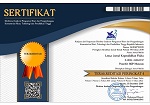PENGEMBANGAN PERANGKAT PEMBELAJARAN FISIKABRAIN-BASED LEARNINGUNTUK MELATIHKAN KETERAMPILAN BERPIKIR KRITIS
DOI:
https://doi.org/10.33394/j-lkf.v4i2.96Keywords:
Brain-Based Learning, Critical Thinking Skills.Abstract
The objective of this research was to develope physics learning materials based on Brain-Based Learningthat are valid, practical, and effective to facilitate student’s critical thinking skills in fluid matter. The learning materials development using 4D development model and have been tested on 10th grade students of The Senior High School of 1 Kopang, academic year 2016/2017, with one group pre-test post-test design trial development research. Data collection methods used were questionnaires validity, tests and observation, whereas data analysis techniques using qualitative and quantitative descriptive analysis. The results were showed several findings: physics learning materials developed had an average score of validity categorized valid, based on the implementation of the lesson plan is obtained that can be done well, especially on elaboration step. The response was very positive towards learning students, critical categorized for student’s critical thinking skills after the trial of physics materials were develop. Based on the results of this trial can be concluded that developement of physics learning material was valid, practical, and effective to facilitate student’s critical thinking skills.
References
Akyurek, E, & Afacan, O, 2013, Effect of Brain-Based Learning Approach on students’ motivation and attitudes levels inscience class, Mevlana International jurnal of Education (MIJE), Vol 3 No 1, pp. 104-119.
Caine dan Caine. 1991. Understanding a Brain-Based Approach to Learning and Teaching. Training and Development Journal.
Duron, H., Limbach B., dan Wough W. 2006. “Critical Thinking Framework to Any Diciplineâ€. International Journal of Teaching and Learning in Higher education. 17 (2): 160-166
Ennis, Robert.H. 1991. Critical Thinking: A Streamlined Conception. Teaching Philosophy. 14:1. University of Illionis.
Ennis, Robert.H. 1996. Critical Thinking. New York: Prentice-Hall.
Ernest, paul. 1991. The philosophy of mathematics education. London: routledge falmer.
Facione P, Giancarlo, Facione N, Gainen J. 1995. “The Disposition Toward Critical Thinkingâ€. Journal of General Education. 44 (1): 1-25.
Facione Peter. 2006. Critical Thinking: What It Is and Why Its Counts. InsightAssessment. Millbrae, CA: California Academic Press.
Facione, Peter. 2011. Critical Thinking. What It Is and Why Its Counts. Measured Reason and The California Academic Press.
Fisher, A. 2003. Critical Thinking An Introduction. Cambridge University Press.
Harkreader, H. 2000. Fundamental of nurse caring and clinical Judgment. Philadelphia: W.B. Sunders Company.
Hasemi S. Ahmad. 2011. “The Use of Critical Thinking in Social Science Textbooks of High School: A Field Study of Fars Province of Iranâ€. International Journal of Instruction. 4 (1): 63-78.
Hassard, Jack. 2005. The Art Teaching Science. New York: Oxford University Press.
Jensen. Eric. 2011. Pembelajaran Berbasis Otak. Jakarta: Indeks
Nieveen, N. 1999. Prototyping to Reach Product Quality. Kluwer Academic Publisher.
Paul, R. dan Elder, L. 2006. Critical Thinking (Concepts and Tools). The foundation for critical thinking.
Phan, Huy. 2010. “Critical Thinking As a Self-Regulatory Process Component in Teaching And Learningâ€. Psycothema. - (22): 289-292.
Setyorini, Sukiswo, dan Subali. 2011. “Penerapan Problem Based Learning untuk Meningkatkan Kemampuan Berpikir Kritis Siswa SMP. Jurnal Pendidikan Fisika Indonesia. 7 (-): 52-56.
Setyowati A. 2011. “Implementasi Pendekatan Konflik Kognitif Dalam Pembelajaran Fisika Untuk Menumbuhkan Kemampuan Berpikir Kritis Siswa SMP Kelas VIIIâ€. Jurnal Pendidikan Fisika Indonesia. 7 (-): 89-96.
Woolfolk, A. 2009. Educational Psychology. Bagian Pertama. New York: Pearson.
Downloads
Published
How to Cite
Issue
Section
License
Authors who publish with Lensa: Jurnal Kependidikan Fisika agree to the following terms:
- For all articles published in Lensa: Jurnal Kependidikan Fisika, copyright is retained by the authors. Authors give permission to the publisher to announce the work with conditions. When the manuscript is accepted for publication, the authors agree to automatic transfer of the publishing right to the publisher.
- Authors retain copyright and grant the journal right of first publication with the work simultaneously licensed under a Creative Commons Attribution-ShareAlike 4.0 International License that allows others to share the work with an acknowledgment of the work's authorship and initial publication in this journal.
- Authors are able to enter into separate, additional contractual arrangements for the non-exclusive distribution of the journal's published version of the work (e.g., post it to an institutional repository or publish it in a book), with an acknowledgment of its initial publication in this journal.
- Authors are permitted and encouraged to post their work online (e.g., in institutional repositories or on their website) prior to and during the submission process, as it can lead to productive exchanges, as well as earlier and greater citation of published work (See The Effect of Open Access).

This work is licensed under a Creative Commons Attribution-ShareAlike 4.0 International License.



